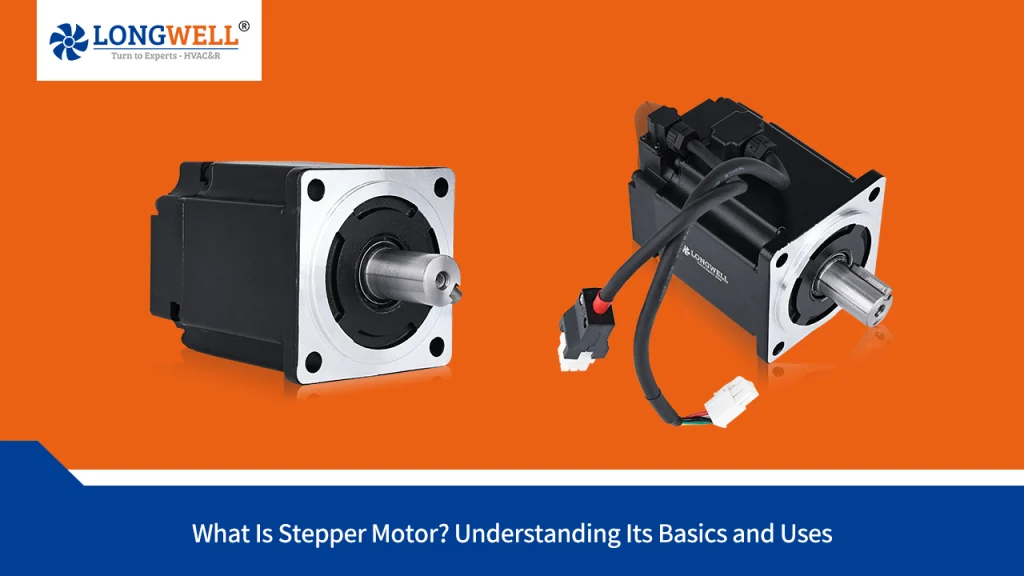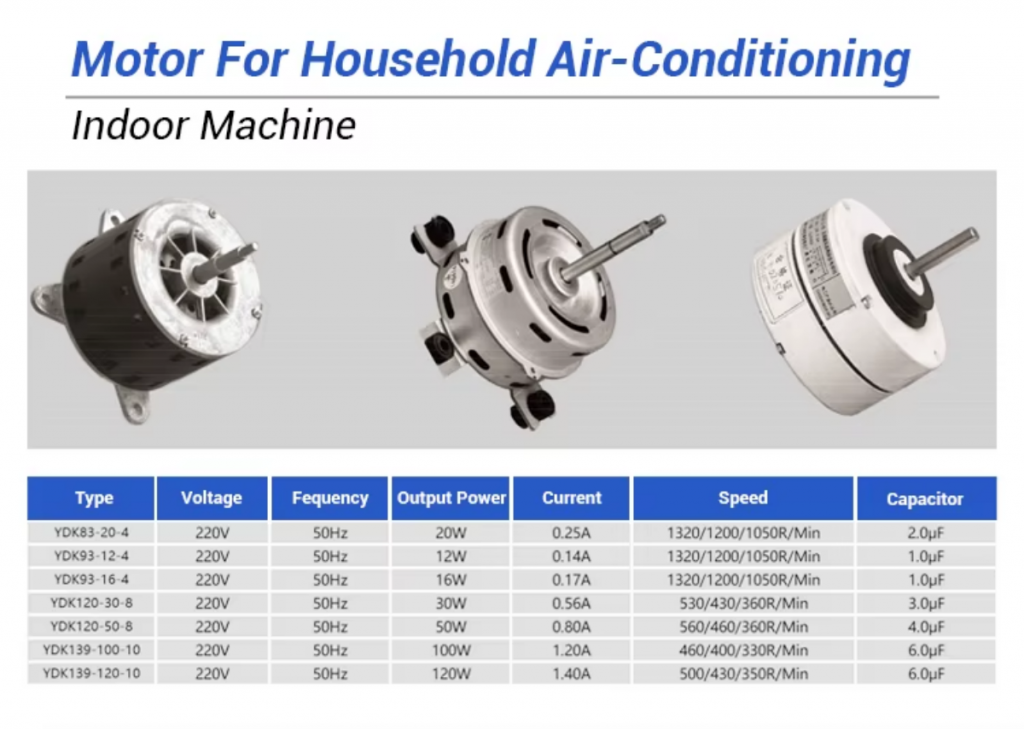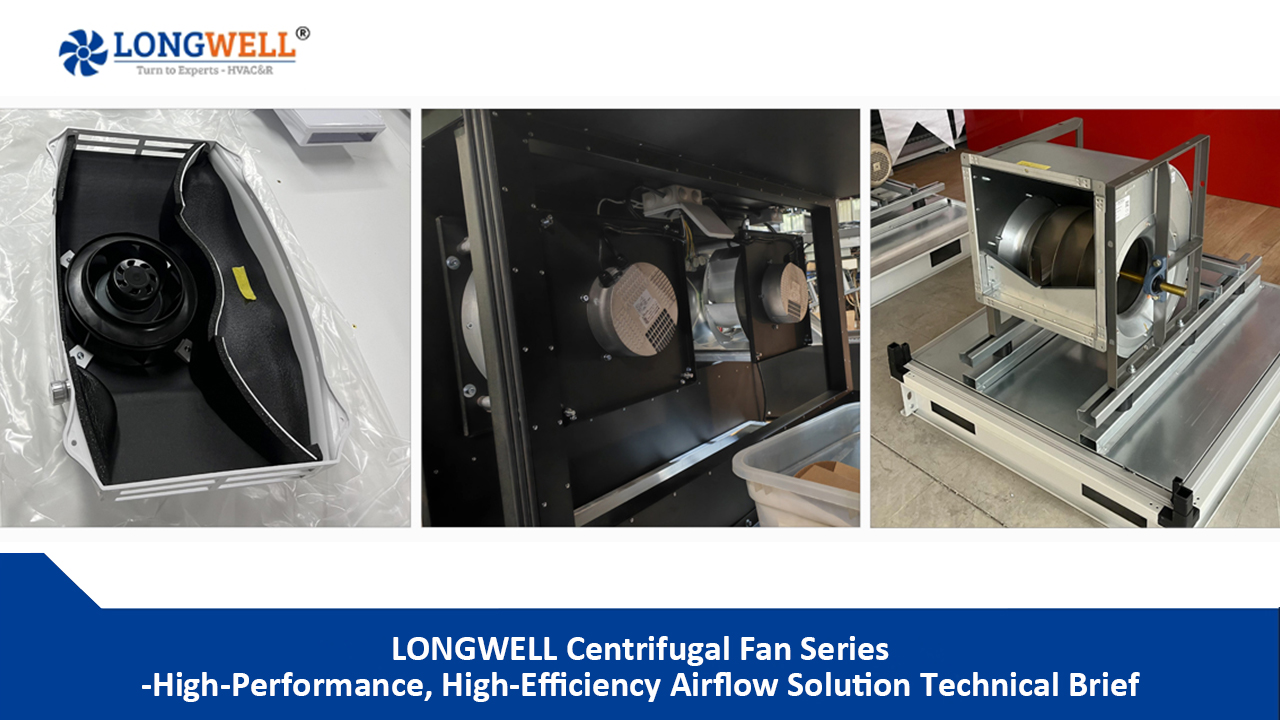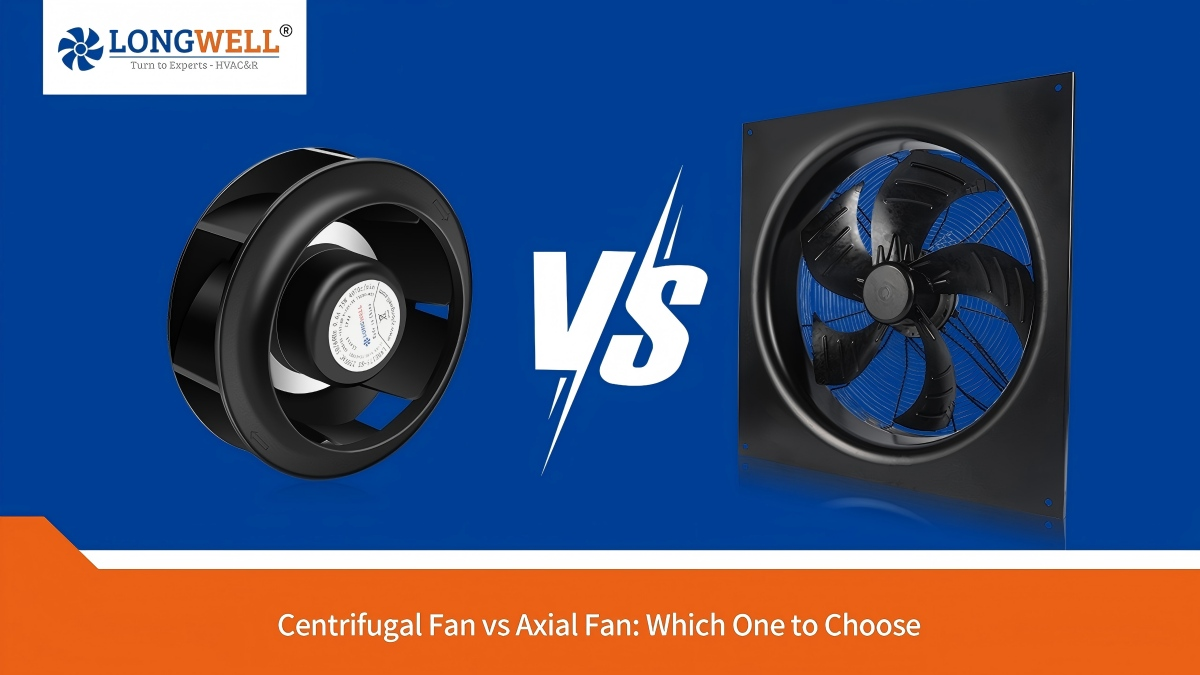
Powering Your World: A Deep Dive into AC Fan Motors
Introduction: Driving Airflow – Why AC Fan Motors Matter
AC fan motors are central to various systems, from everyday air conditioning units to complex industrial ventilation setups. They convert electrical energy into mechanical energy, spinning fan blades to ensure efficient airflow. In HVAC systems, AC fan motors are vital for maintaining cooling efficiency and preventing equipment from overheating.

https://www.longwellfans.com/product-category/ac-motors/ac-capacitor-motor
Unlike DC motors, AC motors operate on the principle of electromagnetic induction, using alternating current to create a rotating magnetic field inside the motor, which then drives the rotor. This design means AC motors don’t need the brushes and commutators often found in DC motors. By skipping these mechanical contact points, AC motors have a simpler build and generally offer better reliability over long periods. This inherent design advantage directly translates to less maintenance and a longer operational life, which is a big plus for industrial and HVAC uses. Picking the right AC fan motor is key to getting the best performance and efficiency.

https://www.longwellfans.com/product-category/dc-motors/bldc-motors

Getting to Know AC Fan Motors: How They Work, Types, and Benefits
This section will dive into the technical heart of AC fan motors, explaining how they work, detailing the various types available, and outlining the advantages they offer in different applications.
How AC Fan Motors Work: The Basics of Air Movement
AC fan motors operate using the principle of electromagnetic induction. Simply put, alternating current creates a changing magnetic field in the motor’s stator (the stationary part). This changing field then induces a current in the conductors of the rotor (the spinning part), which interacts to produce torque, making the rotor spin. It’s this contact-free electromagnetic process that makes AC motors so good at turning electrical energy into mechanical motion.
Looking back, Nikola Tesla’s invention of the AC motor in the late 1880s was a big step forward in electrical engineering. Tesla’s innovation wasn’t just a technical feat; it effectively solved the practical problem of transmitting and using electrical power over long distances, proving more viable than the direct-current systems Thomas Edison championed. AC power became widespread because it could easily change voltage with transformers, allowing for efficient long-distance transmission and distribution. This scaled efficiency is why AC power became the norm, and consequently, AC motors became standard for most applications, including industrial fans. This historical advantage in efficiency directly translates to the cost-effectiveness and broad applicability of today’s AC fan motors.

Exploring Different AC Fan Motor Types for Diverse Needs
There are several types of AC fan motors available, each with its own unique features and suitable applications. Understanding these types helps you pick the best motor for your specific needs.
· Permanent Split Capacitor (PSC) Motors: These motors always have a capacitor in their running circuit, offering moderate torque and suitability for continuous operation. They’re often found in blowers and condenser applications in homes and light commercial setups. Longwell offers AC induction motors with capacitors , which might include PSC types.
· Capacitor Start, Capacitor Run (CSCR) Motors: These use both a start and run capacitor, providing high starting torque, with the start capacitor disconnecting after startup. They’re good for applications needing a lot of initial power, like heavy-duty AC units. Longwell also offers AC capacitor motors.
· Capacitor Start, Induction Run (CSIR) Motors: These only use a start capacitor, giving high starting torque but no run capacitor.

· Three-Phase Motors: These need a three-phase power supply, don’t use capacitors, and offer high efficiency and reliability. They’re typically used in larger commercial HVAC systems and industrial fans. Longwell provides AC motors for industrial applications.
· Shaded Pole Motors: These are small, low-torque motors that only run in one direction, don’t use capacitors, and are budget-friendly. They’re suitable for low-power uses like small fans, bathroom fans, and range hoods. Longwell specifically offers shaded pole HVAC AC motors.

· Electronically Commutated Motors (ECM): These motors offer high efficiency and variable speeds, using permanent magnets and electronically switched DC. They’re a top choice for modern HVAC systems aiming for energy efficiency. Longwell provides EC/BLDC/ECM motors, highlighting their advanced EC technology with up to 90% efficiency and smart control capabilities.
· Blower Motors: These motors circulate air and come in single-speed and variable-speed options. They’re a key part of indoor air conditioning units. Longwell offers various centrifugal and cross-flow fans , which are typically driven by blower motors.
Here’s a summary of common AC fan motor types and their applications:
Table 1: Common AC Fan Motor Types and Their Applications
| Motor Type | Key Features | Typical Applications | Longwell Related Products |
| Permanent Split Capacitor (PSC) | Run capacitor always in the circuit; moderate torque; suitable for continuous operation. | Blower and condenser applications in residential and light commercial systems. | Longwell offers AC induction motors with capacitors , which may include PSC types. |
| Capacitor Start, Capacitor Run (CSCR) | Start and run capacitors; high starting torque; start capacitor disconnects after startup. | Applications requiring high initial power, like heavy-duty AC units. | Longwell offers AC capacitor motors. |
| Capacitor Start, Induction Run (CSIR) | Start capacitor only; high starting torque; no run capacitor. | Specific applications with high initial torque needs. | Longwell offers AC induction motors. |
| Three-Phase Motors | Requires three-phase power; no capacitors; high efficiency and reliability. | Larger commercial and industrial HVAC systems, industrial fans. | Longwell offers AC motors for industrial applications. |
| Shaded Pole Motors | Small, low torque; runs in one direction; no capacitors; economical. | Low-power applications, such as small fans, bathroom fans, range hoods. | Longwell specifically offers shaded pole HVAC AC motors. |
| Electronically Commutated Motors (ECM) | High efficiency; variable speeds; uses permanent magnets and electronically switched DC. | Modern HVAC systems prioritizing energy efficiency, variable airflow needs. | Longwell offers EC/BLDC/ECM motors with advanced EC technology. |
| Blower Motors | Circulates air; single-speed and variable-speed options. | Indoor units of air conditioning systems. | Longwell offers various centrifugal and cross-flow fans, typically driven by blower motors. |

The shift by leading manufacturers, like Longwell, towards Electronically Commutated Motors (ECM) signals a broad industry focus on energy efficiency and variable speed control. While traditional AC motors remain popular for their cost-effectiveness and durability, the growing adoption of ECMs reflects market demand for smarter, more adaptable, and less expensive-to-run solutions, especially in modern HVAC and industrial systems. This trend shows that manufacturers are adjusting their product lines to meet market needs driven by environmental regulations, rising energy costs, and the desire for more complex integrated control systems like IoT and smart buildings. This allows companies offering these solutions to stay ahead in the industry and suggests a shift in customer value propositions from initial cost to total cost of ownership and environmental impact.
Benefits of Choosing an AC Fan Motor
Choosing an AC fan motor brings several practical benefits to your system. These advantages aren’t just about the initial purchase price; they also create value for users over the long run.
First off, energy efficiency is a big plus for AC fan motors, especially the high-efficiency and variable-speed models. They can significantly cut down on energy use compared to older motors, lowering your electricity bills by optimizing how power is used. This efficiency, combined with their cost-effectiveness, makes AC motors a popular choice for folks watching their budget.

– Next, AC motors are known for their durability and long lifespan. They’re built for continuous operation and can handle the tough demands of HVAC systems, helping your entire AC unit last longer. A well-running AC fan motor also takes some strain off other parts, like the compressor, which means fewer repairs and replacements over time. Because AC motors have a simpler design with fewer parts that can break, they also reduce the chance of costly downtime. This combination of durability, low maintenance, and reduced stress on other system components (like the compressor in an HVAC unit) leads to significant operational savings over the product’s lifetime. This goes beyond just the upfront purchase price, covering the total cost of ownership, which is a big deal for industrial and commercial users who need to minimize downtime and repair costs. These inherent qualities make AC motors a strong selling point, showing they’re a smart long-term investment.
– Plus, AC fan motors improve airflow, which is essential for effective cooling. They help pull air through condenser coils, boosting the refrigerant’s cooling process. Many AC fan motors also come with various control options, including wall controls and remotes, making it easy for users to adjust settings for comfort. When it comes to noise levels, while some AC motors can be noisy, advancements have significantly reduced operating noise in high-efficiency models. Variable-speed fans running at lower speeds most of the time further cut down on noise.
– Finally, AC fan motors are versatile, used in many applications beyond just air conditioning, like ventilation systems and industrial fans. They’re also easy to maintain, which adds to their appeal.

The AC Fan Motor Market: Trends, Growth, and Longwells Expertise
This section will outline the current landscape of the AC fan motor market, highlighting recent data, key growth drivers, and Longwell’s position within this evolving industry.
Global AC Fan Motor Market Overview (2024-2025 Data)
The global AC motor cooling fans market was valued at $9.32 billion in 2024 and is expected to hit $9.65 billion in 2025, growing further to $12.86 billion by 2033 at a compound annual growth rate (CAGR) of 3.5% during the forecast period. This steady growth is mainly driven by industrial automation (58% of demand), HVAC modernization (51%), rising electronics cooling needs (46%), and a surge in infrastructure ventilation systems worldwide (43%).
Meanwhile, the air-conditioning equipment market is projected to grow from $213.02 billion in 2024 to $227.6 billion in 2025, with a CAGR of 6.8%. Factors pushing this growth include rapid urbanization, industrial expansion, rising global temperatures, and a growing demand for energy-efficient solutions. The industrial fans market was valued at $7.2402 billion in 2024 and is expected to grow at a CAGR of 4.8% from 2025 to 2030.
Market trends show increasing integration of smart features (54%), demand for low-noise designs (49%), growth in energy-efficient models (45%), and the adoption of IoT-connected building systems and appliances (42%). These trends align with the air-conditioning equipment market’s focus on smart and connected technologies and sustainable refrigerants.

Here’s a summary of the global market data for AC fan motors and related industries:
Table 2: Global Market Overview for AC Fan Motors and Related Industries (2024-2025)

The ongoing emphasis on ‘energy-efficient models’ and ‘smart features/IoT-connected building systems’ shows that customer priorities have moved beyond basic functionality. This means future market growth is closely tied to technological innovations that deliver cost savings through efficiency and enhanced control and integration through smart features, rather than just raw power or low upfront costs.
Drivers of Market Growth and Innovation
Several factors are pushing the AC fan motor market forward, collectively forming a strong force for industry development.
First, rapid urbanization and industrialization are major drivers. As global urban populations grow and industrial activities increase, so does the demand for HVAC equipment, including air conditioning units. For example, by 2050, the world’s urban population is expected to reach about 7 billion, and by 2035, urbanization is projected to add 675 million people to cities. This concentration of people and industry directly boosts the need for efficient ventilation and cooling systems.
Second, rising global temperatures are another significant driver. Increasing average global temperatures lead to a greater need for cooling solutions, especially in areas frequently hit by heatwaves. Air conditioning equipment becomes essential for keeping living and working environments comfortable and livable, while also protecting health and productivity. There’s a clear link between continuously rising global temperatures and the demand for ‘energy-efficient solutions.’ As temperatures climb, the need for cooling naturally goes up, but at the same time, the necessity for responsible and sustainable cooling becomes more apparent. This pushes innovation in efficient AC fan motors and integrated smart systems that can manage energy consumption effectively.
Finally, the growing market focus on energy efficiency and smart solutions is at the heart of innovation. Market reports show increasing demand for energy-efficient models and IoT-connected building systems. This shift isn’t just about cutting operational costs; it’s also about meeting stricter environmental regulations and green building certifications. For instance, 58% of manufacturers install advanced AC cooling fans in factory automation systems, while HVAC modernization projects, especially in North America and Europe, account for 51% of fan demand. This pursuit of efficiency and smart features is prompting manufacturers to develop more advanced, adaptable, and environmentally friendly AC fan motor technologies.
Longwells Commitment to Advanced AC Fan Solutions
Ningbo Longwell Electric Technology Co., Ltd. (Longwell), as an industrial fan manufacturer, plays a significant role in the AC fan motor market. With over 20 years of industry experience, the company has deep technical expertise in the design, development, and manufacturing of fans and motors. Longwell not only provides OEM services for well-known brands but also supplies numerous Fortune 500 companies, with products exported to over 30 countries.

Longwell’s product range is extensive, including EC/DC/AC centrifugal fans, axial fans, AC/BLDC cross-flow fans, single/double forward curved fans, AC/BLDC/ECM motors, and industrial fan blowers. The company particularly focuses on advanced EC technology, with its EC motors achieving up to 90% efficiency and supporting smart controls and Modbus communication. This investment in advanced EC technology aligns well with the market’s demand for energy-saving and smart solutions.
Longwell’s strength is evident in its advanced testing labs and production facilities, with an annual capacity of millions of fans. The company uses advanced technologies like aerodynamics principles and Computational Fluid Dynamics (CFD) simulation to ensure precise and efficient fan designs. This investment in CFD simulation helps optimize fan designs for maximum efficiency and performance, directly meeting the market’s need for energy-saving and compact, high-performance solutions. Additionally, Longwell offers customized services, designing and manufacturing fan systems to meet specific customer requirements.
Longwell’s long-standing experience, combined with its adoption of advanced technologies like CFD simulation and EC motor development, shows the company’s strategic commitment to not just meet current market demands but also to actively shape future solutions. This blend of tradition and innovation indicates that Longwell is more than just a supplier; it’s a strategic partner capable of delivering cutting-edge, customized solutions that align with evolving industry standards and customer expectations for efficiency and reliability. Longwell aims to be a leader in the efficient fan industry by providing high-tech, high-performance products and actively promoting sustainable development.
To explore more of Longwell’s AC fan motor products, visit Longwell AC Fan Motor Products.

Keeping Your AC Fan Motor Running: Troubleshooting and Maintenance Tips
This section will give users practical knowledge to identify and fix common AC fan motor problems, helping extend their lifespan and ensure stable performance.
Common Signs to Watch Out For in AC Fan Motors
Knowing the signs that your AC fan motor might be having issues can help you spot and fix problems quickly. Here are some common indicators:
· Fan Not Starting or Stopping: If the fan doesn’t spin when the AC is on, or keeps running after the AC is off, it could point to a motor problem.
· Slow Fan Speed: If the fan blades turn slowly after the fan starts, it might mean the motor isn’t getting enough power or there’s some mechanical obstruction.
· Unusual Noises: Rattling, grinding, or a continuous humming sound coming from the condenser unit often signals worn bearings or a lack of lubrication. A high-pitched squealing sound also frequently points to worn bearings.
· Overheating Motor: If the motor casing feels unusually hot during operation, or if there’s visible discoloration or burn marks, it could be overheating. This might be due to electrical issues or mechanical wear.
· Fan Blades Not Spinning: Besides the motor not starting, if the fan blades aren’t spinning at all, or seem stuck or rotating erratically, it suggests the motor shaft or bearings aren’t effectively transmitting motion.
· Intermittent Operation: If the fan works sometimes and stops at others, or struggles to start consistently, this could be a sign of an intermittent problem.
· Clogged Blades: Dirt and debris buildup on fan blades can throw them off balance, affecting their proper rotation.
Many common AC fan motor issues, like slow speeds, noise, or overheating due to dirt or debris, are often symptoms of preventable problems rather than inherent motor failures. This means that simple, proactive maintenance steps can significantly reduce the chances of costly repairs or early motor replacement, highlighting how important user awareness is.
Simple Steps to Diagnose AC Fan Motor Problems
If you suspect your AC fan motor is acting up, here are some simple steps you can follow for a safe and effective diagnosis:
1. Check the Power: First, always turn off the power to your AC unit to stay safe. Then, check if the circuit breaker has tripped. If the power supply seems fine, check for a fuse in the low-voltage circuit to make sure it’s intact.
2. Inspect the Windings: Use a multimeter to measure the ohms of the motor windings to check for a short circuit. A reading of zero on the multimeter means the winding is shorted, while an infinite reading indicates an open winding. Both scenarios suggest a faulty motor that likely needs replacing.
3. Examine the Capacitor: Even if the power and windings are fine, the capacitor could be the problem. The capacitor gives the motor the torque it needs to run. A faulty capacitor can lead to insufficient power, affecting how parts like the fan belt and blower wheel operate. Before checking the capacitor, make sure it’s discharged. You can visually inspect the capacitor for signs of bulging, leaking, or burn marks. Then, use a capacitor tester to check its microfarad reading, making sure it’s within 10% of the capacitor’s rated capacitance. Capacitors are relatively inexpensive and easy-to-replace parts in the system. Their frequent failure (often due to heat or age) means many seemingly ‘motor failure’ situations are actually just a bad capacitor. This insight is really valuable for users because it encourages targeted diagnosis before assuming a full motor replacement is needed, saving time, money, and unnecessary replacements.
Maximizing Lifespan: Essential AC Fan Motor Maintenance
To extend the life of your AC fan motor and keep it running efficiently, regular maintenance is really important.
· Regularly Clean Fan Blades: Over time, dirt and debris can build up on fan blades, causing them to become unbalanced and affecting motor operation. Regularly cleaning the fan blades with a soft cloth or brush can effectively prevent this issue.
· Check Electrical Connections: Incorrect wiring or loose, corroded electrical connections can cause the motor to overheat or not work properly. With the power off, check all screw terminals, wire nuts, and plug connections to make sure they’re tight and free of corrosion or heat damage.
· Watch for Bearing Wear: Grinding, humming, or continuous rumbling noises from inside the motor often indicate worn bearings. Catching and addressing these issues early, like lubricating, can prevent more serious damage.
· Address Capacitor Issues Promptly: If the capacitor shows obvious signs like bulging, leaking, or burn marks, or if testing shows its performance has dropped, it should be replaced right away.
By following these simple maintenance steps, users can significantly extend the lifespan of their AC fan motors and ensure consistent, reliable performance. Many AC fan motor problems come from environmental factors or simple mechanical wear, not manufacturing defects. This highlights the user’s role in proactive maintenance and shows that a small investment of time in upkeep can lead to big returns, including longer product life and consistent performance.
Longwell offers a range of industrial fan solutions that can achieve optimal performance with proper motor maintenance. To learn more, visit(https://www.longwellclimate.com/products/).
Conclusion: Your Partner for Efficient Airflow Solutions
AC fan motors are an indispensable part of modern HVAC and industrial systems, ensuring efficient airflow by converting electrical energy into mechanical motion. From home air conditioners to large industrial equipment, these motors offer reliable solutions for various applications, thanks to their energy efficiency, cost-effectiveness, durability, and ease of maintenance.
The global AC fan motor market is seeing steady growth, driven especially by industrial automation, HVAC modernization, electronics cooling, and the increasing global demand for energy-saving and smart solutions. Rapid urbanization and rising global temperatures further accelerate the need for efficient cooling and ventilation equipment.
Ningbo Longwell Electric Technology Co., Ltd., a leading industrial fan manufacturer, shows strong expertise in the AC fan motor field with over 20 years of industry experience. Longwell offers a diverse product line, including EC motors, and ensures high efficiency and quality through advanced CFD simulation technology and customized services. The company’s dedication to technological innovation and sustainable development allows it to provide advanced solutions that meet future trends for global customers. Longwell’s long-standing experience provides a deep understanding of customer needs and manufacturing processes, building trust and reliability. Its investment in CFD simulation helps optimize fan designs for maximum efficiency and performance, directly meeting the market’s need for energy-saving and compact, high-performance solutions. This blend of tradition and innovation shows that Longwell is more than just a supplier; it’s a strategic partner capable of delivering cutting-edge, customized solutions that align with evolving industry standards and customer expectations for efficiency and reliability. Longwell is committed to providing high-quality, high-performance, and reliable AC fan motor solutions, making it your ideal partner for efficient airflow.

Frequently Asked Questions (FAQs)
1. What are the common types of AC fan motors used in HVAC systems? Common AC fan motors used in HVAC systems include Permanent Split Capacitor (PSC) motors, Shaded Pole motors, Three-Phase motors, Electronically Commutated Motors (ECM), and Blower motors. Each type has specific performance characteristics and applications; for example, PSC motors are often used in residential blowers, while ECMs are popular in modern energy-efficient systems due to their high efficiency and variable speed capabilities.
2. How do you troubleshoot common issues like slow speed or unusual noise in an AC fan motor? If your AC fan motor is running slowly or making unusual noises, first check the fan blades for dirt and debris buildup, as this can affect balance and rotation. Next, inspect the motor bearings for signs of wear, such as grinding or high-pitched squealing sounds. Also, check the capacitor for damage, as a faulty capacitor can lead to insufficient motor power, impacting speed.
3. What are the main benefits of choosing an energy-efficient AC fan motor for industrial applications? Choosing an energy-efficient AC fan motor for industrial applications offers several benefits. They can significantly reduce operational energy consumption and electricity bills , helping businesses comply with increasingly strict environmental regulations and green building certifications. Additionally, energy-efficient motors are often quieter, last longer, and require less maintenance and downtime, which lowers the total cost of ownership.


